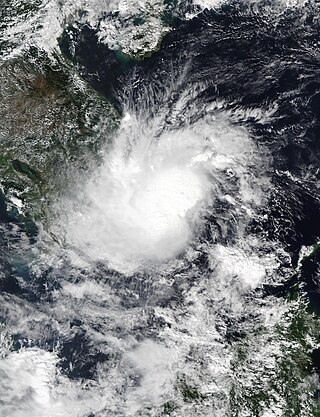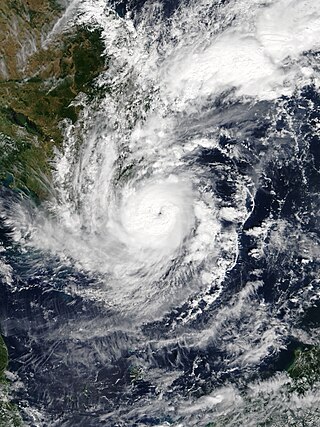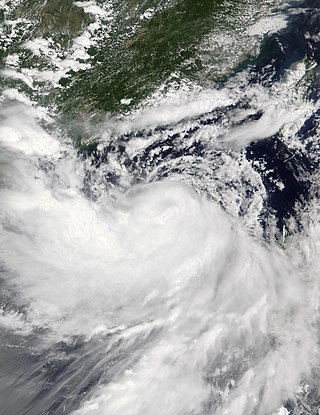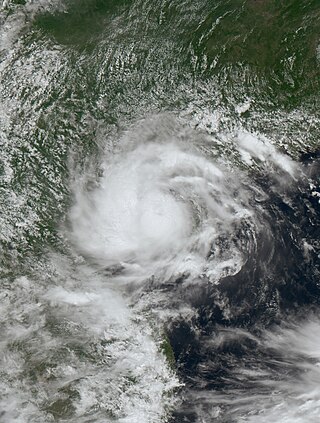
Typhoon Xangsane, known in the Philippines as Typhoon Milenyo, was a typhoon that affected the Philippines, Vietnam, and Thailand during the 2006 Pacific typhoon season. The name Xangsane was submitted by Laos and means elephant.

The 2017 Pacific typhoon season was a below-average season in terms of accumulated cyclone energy and the number of typhoons and super typhoons, and the first since the 1977 season to not produce a Category 5-equivalent typhoon on the Saffir–Simpson scale. The season produced a total of 27 named storms, 11 typhoons, and only two super typhoons, making it an average season in terms of storm numbers. It was an event in the annual cycle of tropical cyclone formation, in which tropical cyclones form in the western Pacific Ocean. The season runs throughout 2017, though most tropical cyclones typically develop between May and October. The season's first named storm, Muifa, developed on April 25, while the season's last named storm, Tembin, dissipated on December 26. This season also featured the latest occurrence of the first typhoon of the year since 1998, with Noru reaching this intensity on July 23.

The 2018 Pacific typhoon season was at the time, the costliest Pacific typhoon season on record, until the record was beaten by the following year. The season was well above-average, producing twenty-nine storms, thirteen typhoons, seven super typhoons and six Category 5 tropical cyclones. The season ran throughout 2018, though most tropical cyclones typically develop between May and October. The season's first named storm, Bolaven, developed on January 3, while the season's last named storm, Man-yi, dissipated on November 28. The season's first typhoon, Jelawat, reached typhoon status on March 29, and became the first super typhoon of the year on the next day.

Tropical Depression 18W was a tropical depression that impacted Vietnam, Laos and Thailand during mid September 2013. The system was first noted as a tropical depression on September 16, 2013, while it was located within the South China Sea to the south east of Hanoi in Vietnam. Over the next two days the system gradually developed further, before it was reported by the Vietnamese National Centre for Hydro Meteorological Forecasting that the system had developed into their eighth tropical storm of 2013. However, other meteorological agencies did not report that the system had developed into a tropical storm.

Tropical Storm Kujira was a tropical cyclone that prompted the PAGASA to declare the beginning of the rainy season in the Philippines. The ninth tropical depression, 8th named storm, and first storm to make landfall on China in the 2015 Pacific typhoon season, it formed as a tropical depression south of the Paracel Islands on June 19.

Tropical Storm Vamco was a weak tropical cyclone which affected Indochina in mid-September 2015. Formed from a tropical disturbance on September 13, the system developed into a tropical storm and reached its peak intensity on September 14. Vamco made landfall in Vietnam and affected Laos, Thailand and Cambodia. The storm caused flooding in these countries and damages amounted to US$14.1 million. Fifteen people died in the floods.

Severe Tropical Storm Mirinae was a tropical cyclone of moderate intensity that struck Hainan Island, China and Northern Vietnam in late July 2016. The third named storm of the annual typhoon season, Mirinae formed on July 25, 2016 as a tropical depression west of Luzon, Philippines. On July 26, it moved west-northwestwards, and it had intensified into a tropical storm before making landfall on Hainan Island, China. After passing over Hainan, it intensified into a severe tropical storm and made landfall over the Red River Delta in Northern Vietnam late on July 27, and dissipated the next day.

Severe Tropical Storm Talas was a tropical cyclone that affected Vietnam in mid-July 2017. The storm was first identified as a tropical disturbance over the South China Sea on July 13 and was upgraded to a tropical depression the following day. On July 15, the depression intensified into a named storm of the 2017 Pacific typhoon season. Before making landfall in Vietnam, Talas reached its peak intensity as a severe tropical storm on July 16. It weakened to an area of low pressure on July 17 as it moved inland. Throughout Vietnam, the storm resulted in 14 fatalities and damaged approximately 2,700 homes. Rough seas caused about 50 boats to sink. Nearly 50,000 hectares of vegetable fields, around 800 ha of aquaculture, and 47,600 ha of rice and other subsidiary crops were affected. The storm caused an estimated US$8.8 million in damages in Hainan, China, increased rainfall in Myanmar and Thailand, and triggered landslides and flooding in parts of Central and Northern Laos.

Tropical Storm Sonca was a weak tropical cyclone that impacted Southeast Asia during the end of July 2017. As the 10th named storm of the 2017 Pacific typhoon season, Tropical Storm Sonca formed south of Hong Kong, after drifting westward for multiple days, the storm intensified into a tropical storm, receiving the name Sonca. The storm later affected Hainan, reaching its peak intensity. On July 25, the storm made landfall over the Quảng Trị province, then dissipated.

Typhoon Damrey, known in the Philippines as Severe Tropical Storm Ramil, was a strong tropical cyclone that affected the Philippines and Vietnam during early November 2017. Damrey first originated as a tropical depression over the Philippine archipelago of Visayas on October 31. Emerging into the South China Sea a few days later, the system strengthened into the second deadliest and twenty-third named storm of the 2017 Pacific typhoon season. Rapidly intensifying, Damrey became the season's tenth typhoon on November 3, reaching its peak intensity as a Category 2 on the same day. Damrey made landfall over Khánh Hoà, Vietnam on November 4 and began to rapidly weaken, fully dissipating on November 5.

Tropical Storm Son-Tinh, known in the Philippines as Tropical Storm Henry, was a weak but very deadly tropical cyclone that devastated Vietnam and Laos in July 2018. Son-Tinh originated from an area of low pressure over the Philippine Sea on July 15, 2018. Moving quickly westwards, Son-Tinh strengthened to the ninth tropical storm of the annual typhoon season on July 17. Intensifying only slightly while crossing the South China Sea, Son-Tinh made its first landfall over Hainan Island on July 18. After emerging into the Gulf of Tonkin, Son-Tinh restrengthened before making its second landfall as a tropical storm in Northern Vietnam on July 19. Once inland, Son-Tinh weakened into a low pressure area as it slowed and made a clockwise loop. The remnants of Son-Tinh then emerged back over water and regenerated into a tropical depression late on July 21.

Tropical Storm Toraji was a weak, short-lived system that impacted Vietnam in November 2018. Forming as the twenty-seventh named storm of the 2018 Pacific typhoon season, Toraji developed as a tropical depression to the southeast of Vietnam on November 16. Quickly organising, the system strengthened into a tropical storm the next day. Toraji rapidly weakened thereafter early on November 18, when the storm made landfall over southeastern Vietnam, later dissipating. The storm's remnants moved into the Gulf of Thailand when Toraji re-organised back into a tropical depression on November 20. However Toraji quickly deteriorated on the same day as it moved closer to the Malay Peninsula.

Severe Tropical Storm Usagi, known in the Philippines as Tropical Storm Samuel, was a tropical cyclone that affected the Philippines and Southern Vietnam in late November 2018, causing severe damage around the Visayas region and Ho Chi Minh City. The storm formed from a disturbance in the Central Pacific basin on November 3, but did not develop into a tropical storm until almost three weeks later, on November 13. Usagi underwent rapid intensification and peaked in intensity before making its final landfall on Vũng Tàu, Bà Rịa–Vũng Tàu province as a weakening tropical storm on November 25. While never considered as a typhoon by the Japan Meteorological Agency (JMA), the Joint Typhoon Warning Center (JTWC) assessed its intensity to be equivalent to Category 2 status on the Saffir–Simpson scale. Usagi caused one death and ₱52.2 million (US$992,000) in damages in the Philippines, most of which came from agriculture. Usagi caused 3 deaths and ₫925 billion in damages in Vietnam.

Tropical Storm Linfa was a weak, short-lived but deadly and destructive tropical cyclone that was the twelfth wettest tropical cyclone on record and the second of nine tropical cyclones in a row to strike Vietnam in 2020, a little under a month after the less damaging Tropical Storm Noul. The fifteenth named storm of the 2020 Pacific typhoon season, Linfa originated from a tropical depression which formed just to the west of the Philippines on October 6. After passing through the island nation, the storm emerged into the South China Sea and slowly gained strength, earning the name Linfa on October 10 on approach to Vietnam. On the next day, Linfa had reached peak strength and made landfall in Vietnam, marking the beginning of a devastating series of floods in the country and worsening the already active monsoon season. Linfa quickly dissipated as it moved inland, but associated thunderstorms continued for several days.

Severe Tropical Storm Conson, known in the Philippines as Typhoon Jolina, was a strong tropical cyclone that impacted the central Philippines and Vietnam during the 2021 Pacific typhoon season. Being the thirteenth named storm of the said event, Conson originated as a low-pressure area first monitored approximately 500 km (310 mi) west of Guam. It formed as a tropical depression over the Pacific Ocean on September 5, 2021. As it formed within the Philippine Area of Responsibility, the Philippine Atmospheric, Geophysical, and Astronomical Services Administration (PAGASA) named the storm Jolina. Over the next day, it intensified into a tropical storm and was named Conson by the Japan Meteorological Agency (JMA). As the storm neared Samar Island, it intensified into a severe tropical storm, and later into a typhoon according to the PAGASA prior to its first landfall in Eastern Samar. The storm retained its strength as it crossed Visayas and later Calabarzon before weakening over Manila Bay prior to its final landfall in Bataan. It subsequently emerged into the South China Sea where it struggled to reintensify further. It then weakened into a tropical depression just offshore of Vietnam before moving ashore near Da Nang. It then rapidly weakened before dissipating on September 13.

Vietnam is a southeast Asian country, and is the easternmost country of mainland Southeast Asia. It borders the South China Sea, hence, seeing the increased likeliness of tropical cyclones. Tropical cyclones in this area are considered to be part of the Northwest Pacific basin, and therefore, storms here are considered as typhoons.

Severe Tropical Storm Ma-on, known in the Philippines as Severe Tropical Storm Florita, was a tropical cyclone that impacted the Philippines in August 2022. The ninth named storm of the 2022 Pacific typhoon season, Ma-on originated as a disturbance over in the Pacific Ocean on August 18, and was upgraded to a tropical depression during the next day. The depression strengthened into a tropical storm receiving the name Ma-on, and became a severe tropical storm late on August 23 before making landfall in the Philippines. It would later make landfall in China and Vietnam on August 25. Ma-on weakened back to a tropical depression and due to unfavorable conditions it dissipated on August 26, 2022.

Severe Tropical Storm Prapiroon, known in the Philippines as Tropical Depression Butchoy was a compact tropical cyclone that made landfall in Hainan and Vietnam in July 2024. It was the fourth named storm of the annual typhoon season. Prapiroon was first identified as an area of persistent convection southeast of Manila, Philippines, on July 15. Several days later, the low-pressure system crossed into the South China Sea. As the storm progressed northwestward along the southern edge of a mid-level subtropical ridge, it intensified into a tropical storm and was named Prapiroon by the Japan Meteorological Agency (JMA) around 00:00 UTC on July 21. However, a few hours later, wind shear and dry air entrainment began to affect the storm. Despite this, deep convection continued to build around the center over the next six hours, resulting in a compact system as it approached Hainan. Prapiroon made landfall near Wanning, Hainan, with winds of 95 km/h (60 mph). After making landfall, the storm maintained its well-defined eye while moving across central Hainan, leading the JMA to upgrade it to a severe tropical storm at 00:00 UTC on July 23. On July 22, the JMA estimated peak 10-minute sustained winds of 100 km/h (65 mph) and a minimum barometric pressure of 985 hPa (29.09 inHg). Despite having persistent deep convection over its center earlier, Prapiroon soon encountered high wind shear and a dry environment. By the same day, it made its second landfall in Quảng Ninh, Vietnam, becoming the first tropical cyclone to strike Vietnam in 640 days. The JMA indicated that the storm dissipated, marking the end of Prapiroon's time as a tropical cyclone on July 25.

Tropical Storm Soulik, known in the Philippines as Tropical Depression Gener, was a weak tropical cyclone that impacted both the Philippines and Vietnam. It formed as the fifteenth named storm of the annual typhoon season in September 2024, Soulik originated from a low-pressure area to the east-northeast of Manila, Philippines on September 14, when it was designated as tropical depression Gener due to its formation within the Philippine Area of Responsibility on September 16. The system gradually shifted westward along the southern edge of a mid-level subtropical high, making landfall in Palanan, Isabela, on September 17. As it traveled further into Luzon, it weakened while encountering the rugged terrain of the Cordillera Central. After emerging over the South China Sea on the next day, the system displayed a broad, disorganized low-level circulation. Although two disturbances in the South China Sea were initially expected to merge closer to Vietnam, the Joint Typhoon Warning Center considered merging these disturbances into one system. Early the next day, the depression strengthened into a tropical storm named Soulik by the Japan Meteorological Agency (JMA). Soulik made landfall near Quang Binh and Quảng Trị, Vietnam, at around 2 p.m. local time. It quickly weakened to a tropical depression due to land interaction, and the JMA continued to monitor the system until it dissipated on September 20.

Typhoon Yagi, known in Vietnam as Typhoon No. 3 of 2024, originated from a tropical depression northwest of Palau, entered the South China Sea, and rapidly intensified into a super typhoon. By 7 September, Yagi made landfall in Vietnam's Haiphong City and Quảng Ninh Province, causing catastrophic damage to lives and property. The typhoon and post-typhoon severe weather brought strong winds and heavy rainfall to the entirety of northern Vietnam, triggering a series of adverse effects such as flash floods and landslides in mountainous areas. It also resulted in historic floods in northern Vietnam in early September 2024.
































